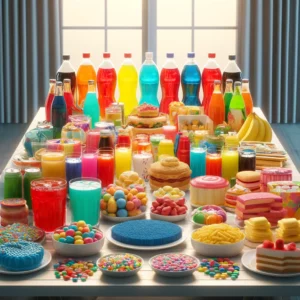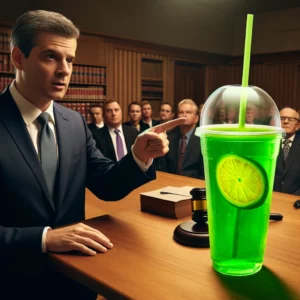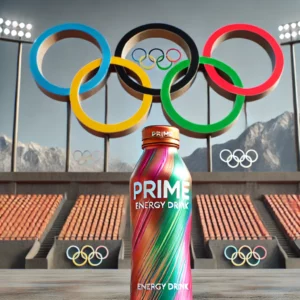A Mother’s Warning: The Unexpected Peril of a Popular Treat
A recent incident involving a two-year-old girl has sparked concern about the safety of Slush Puppies for young children. Arla Agnew’s near-death experience after consuming the popular icy drink has raised awareness about the potential dangers of glycerol, a key ingredient in these beverages.
5 Key Points
- Glycerol in Slush Puppies can cause severe reactions in children under 4
- Symptoms include unconsciousness, low blood sugar, and grey skin tone
- FSA advises against giving glycerol-containing drinks to children under 4
- Warning labels are not mandatory on products containing glycerol
- Parents should check ingredients for glycerol/glycerine or additive E422
Understanding Glycerol in Slush Puppies
Glycerol, or glycerine, is a chemical compound commonly used in slush drinks to prevent them from freezing solid. While it serves a functional purpose in these beverages, it can pose significant health risks to young children. The Food Standards Agency (FSA) advises that drinks containing glycerol are unsuitable for children under four.
Slush Puppies, a global brand created in the 1970s, has become increasingly popular worldwide. The widespread availability of these drinks, including machines designed for domestic use, has made it easier for young children to access them. However, the incident involving Arla Agnew highlights the importance of understanding the potential risks associated with these seemingly harmless treats.
The Dangers of Glycerol for Young Children
The case of Arla Agnew illustrates the severe reactions that glycerol can trigger in young children. Within 30 minutes of consuming a small cup of Slush Puppie, Arla became “completely lifeless” and turned grey. Medical professionals later determined that she had gone into hypoglycemic shock, a condition characterized by abnormally low blood sugar levels.
Symptoms of glycerol-induced reactions in young children may include:
- Sudden loss of consciousness
- Grey skin tone
- Abnormally low blood sugar levels
- Difficulty staying awake
- Rapid deterioration of overall health
In Arla’s case, doctors suggested that she was potentially 20 minutes away from a fatal outcome, underscoring the severity of such reactions.
Current Guidelines and Labeling Practices
In August 2023, the Food Standards Agency introduced new voluntary guidelines recommending that slush-ice drinks be avoided by children under four years old. This decision followed a risk assessment that found these beverages could cause headaches and sickness in young children.
However, a significant issue remains: printing warnings on glycerol products is optional. This lack of clear labeling can leave parents and caregivers unaware of the potential risks associated with these drinks. The FSA is working with the trade to improve consumer information on slush ice products containing glycerol.
Steps for Parent and Caregiver Awareness
Given the potential risks associated with glycerol in Slush Puppies and similar products, parents and caregivers should take the following precautions:
- Check ingredients: Look for glycerine/glycerol or the additive number E422 in the ingredients list.
- Age restrictions: Avoid giving slush drinks to children under four years old.
- Educate others: Share the risks with family members, friends, and caregivers.
- Be vigilant: Monitor children for any unusual symptoms after consuming icy drinks.
- Seek immediate medical attention: If a child shows signs of distress after consuming a slush drink, seek medical help promptly.
Industry Response and Future Considerations
The incident involving Arla Agnew has prompted discussions about the responsibility of manufacturers and retailers to ensure consumer safety. B&M, the retailer from which the Slush Puppie machine used in this case was purchased, stated that its current stock “adheres to the Food Standard Agency’s guidance.”
However, the voluntary nature of the FSA’s guidelines means that not all manufacturers may follow these recommendations. This gap in regulation highlights the need for more stringent measures to protect young consumers.
As awareness grows, regulatory bodies and manufacturers may be under increased pressure to implement mandatory warning labels and stricter guidelines for the sale and consumption of glycerol-containing beverages.
FAQ
Q: Do you qualify for a personal injury lawsuit?
A: To see if you qualify, click here.
Q: What is glycerol, and why is it used in Slush Puppies?
A: Glycerol is a chemical compound that prevents slush drinks from freezing solid. It’s also known as glycerine or E422.
Q: Are Slush Puppies safe for all children?
A: The FSA advises against giving glycerol-containing drinks to children under four years old due to potential health risks.
Q: What are the symptoms of glycerol-induced reactions in young children?
A: Symptoms include unconsciousness, grey skin tone, low blood sugar, and difficulty staying awake.
Q: How can parents identify products containing glycerol?
A: Check the ingredients list for glycerine/glycerol or the additive number E422.
Q: Are warning labels mandatory for products containing glycerol?
A: Warning labels are not currently mandatory, but the FSA is working to improve consumer information on these products.
Citations:
Sanderson, D. (2024, July 31). Mother warns after daughter almost dies from glycerol in Slush Puppie. MSN. https://www.msn.com/en-us/news/world/mother-warns-after-daughter-almost-dies-from-glycerol-in-slush-puppie/ar-BB1qY7Cl






